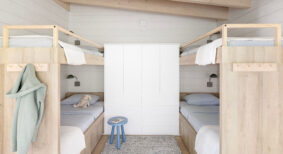Advancements in medical technology have given way to less invasive procedures, shorter hospital stays and faster recovery times. As a society, we are becoming more involved in our healthcare, seeking out a collaborative treatment style.
When thinking of healthcare furniture design, visions of utilitarian shapes, sterile (read: bland) finishes and clunkiness come to mind. While durability has been the central concern for healthcare furnishings of the past, today’s medical practice is placing flexibility and comfort higher on their list of priorities.
Flexibility
Flexibility can be thought of in two ways: immediate and long term. Experts predict a 21 per cent increase in outpatient demand over the next 10 years, including procedures, office visits, imaging and physical therapy. Shorter individual visits means higher patient turnover, so clinics are seeing a greater number of people on any given day. Meeting the needs of so many patients in a short period of time demands immediate adaptability. Furniture must serve multiple purposes and uses, allowing an examination space to also be used for administering treatment.
Longer-term adaptability allows a healthcare facility to evolve along with technological advancements and changes in treatment protocols. One of the most important changes in healthcare furnishings is the emergence of modular case goods to replace static millwork. These units are comprised of specialized wall panels that accommodate a variety of cabinets, shelving, work surfaces and equipment mounts. These allow components to be switched, moved and added as needed, giving medical spaces agility that built-in millwork never could.
A 2012 study by Herman Miller examining the cost savings for Bluewater Health in Sarnia, Ontario, found that the initial build-out savings by using modular casework were 11 per cent over built-in millwork. Those savings rocketed to 74 per cent at the time of their first re-design of the facility. This is a result of low waste and high re-use of their existing case goods, as well as far lower down time as compared to a second new build-out. Multi-purpose furniture options also offer savings by allowing clinics to maintain a smaller footprint and keep real estate costs low.
Comfort
Just as the evolving world of health technology dictates the design of healthcare facilities, so does consumer demand. As patients become more proactive about their own healthcare, practitioners must keep up with the expectations of their patients. The clinic of the future is a community gathering place, a centre for health and wellness with a more engaging and comfortable atmosphere.
In a recent article on the Fast Company Futurists Forum, writer Sarah Bader hypothesizes a future amalgamation of health clinic with coffee shop, library and Apple store. They may not be far off. Patients, especially the now aging baby boomer generation, have higher expectations for their healthcare. They want a comfortable, clean and inviting environment and a place to expand their own health knowledge. To achieve this, furnishings must move away from the traditional healthcare look to a more welcoming residential feel.
Advancements in infection-control finishes, an increased understanding of wear patterns, and a focus on design by manufacturers have resulted in some practical and durable healthcare-specific furnishing that wouldn’t look out of place in a contemporary office environment. Integration of technology takes the patient experience even further for a greater level of comfort.
There is no question that durability is and always will be a key factor in selecting any healthcare furniture. Every selection must not only stand up to continued patient use, but also rigorous cleaning that often done with harsh agents. But as medical technology advances and patients take more ownership of their care, the healthcare environment must lower its armour in favour of a more adaptive and inviting approach.
Amber Kingsnorth, RID, is a registered interior designer and LEED accredited professional. She is owner and principal of MãK Interiors.







